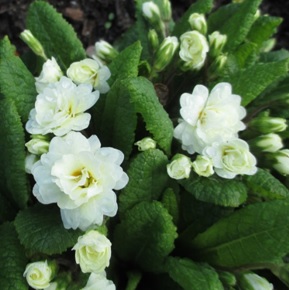Primula ‘Pridhamsleigh’
There is nothing so lovely as the sight of banks of wild primroses in our Devon lanes, and once in a while they throw up interesting variations. One of these is Primula ‘Pridhamsleigh’ a double version of the wild primrose Primula vulgaris. As you can guess from the name it is a Devon native found near Pridhamsleigh, famous for its cave system. It is also known locally as the Ashburton Primrose. The original plant was found in 1968 by Mrs Charles Hilliard just where the A38 was being widened into its current dual carriageway. She brought it to Derek Woolacott, the Ashburton postman, who then distributed the plant. Pieces went to RHS Wisley and RHS Rosemoor – neither of whom seem to have it any longer. It is mentioned in the Magic Tree (published by the NCCPG in 1989), and has featured in several local newspaper articles. They all repeat the comment that the plant tends to produce a single flower first and then double blooms as the flowering goes on. My plant came from Mary Woolacott, Derek’s widow, and she has never noticed it do this, and neither have I.
T he nice thing about plants like this is that they tend to come with a story. For me the plant is inextricably linked to meeting Mary, a delightful warm personality, and hearing stories of her husband’s rural postal round – such as him ferrying calves in his post van between farms with his delivery. I don’t think this is likely to happen these days! Mary herself propagated a good number of ‘Pridhamsleigh’ a couple of years ago so they could be planted around the parish church in Ashburton.
he nice thing about plants like this is that they tend to come with a story. For me the plant is inextricably linked to meeting Mary, a delightful warm personality, and hearing stories of her husband’s rural postal round – such as him ferrying calves in his post van between farms with his delivery. I don’t think this is likely to happen these days! Mary herself propagated a good number of ‘Pridhamsleigh’ a couple of years ago so they could be planted around the parish church in Ashburton.
There are other named double versions of the wild primrose. Interestingly they all vary in the arrangement of their petals, texture of leaves, and shade of yellow. Perhaps the best known is ‘Elizabeth Dickey’ which was found near Ballymoney in County Antrim in the 1930s by a child of that name. Dr Molly Sanderson, a local GP connected to many good garden plants, received it from one of her patients, grew it in her garden and gave pieces to many friends. It was widely grown in Ireland and was in many Dublin gardens at one time. Sadly I have yet to find any trace of the plant, but it is recorded in lovely botanical illustrations by both Wendy Walsh and in Barbara Shaw. I do have a tiny plant of another double said to have been found by Molly Sanderson whilst out picnicking with friends, and called ‘Boyne Valley’. It is a difficult little plant however and it flowered for me for the first time this year – just one flower. Gratifyingly after all the care it has had it is forming a second crown now however.
To my mind these wild variations have a charm and freshness that the deliberately bred doubles lack. ‘Val Horncastle’ is an excellent and vigorous pale yellow double with tight petals, a brighter shade of yellow than ‘Pridhamsleigh’, which is such a pale primrose yellow as to be almost white – as wild primroses so often are. David Kerley has bred another excellent pale yellow double primrose as one of his Belarina range of doubles: ‘Belarina Cream’. It is a very good plant and quite close in appearance to a wild double; it has quite a strong scent that easily scents a small greenhouse if grown in a pot. Excellent plants though these are they don’t have the charm or the connections that the wild variations have however.